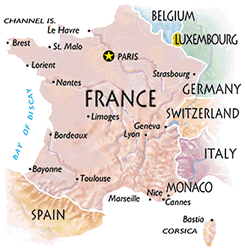
 France
France

Official Name
R�publique Fran�aise (Republic of France)
National Anthem
LaMarseillaise, since 1795
National Motto
Libert�, Egalit�, Fraternit�
(Liberty, Equality, Brotherhood)
Flag
In 1789, La Fayette added the color white, symbolizing royalty, to the red and blue cockade of the Paris National Guard. The tricolor is the official standard of the French Republic.
TotalArea
547,026 km2 (212,918 square miles)France's land surface can be roughly compared to a hexagon
Climate
France lies between latitudes 42.5 to 51 north and longitudes 5 west to 8 east. This location gives France three types of climates: oceanic (West), Mediterranean (South) and continental (Center and East)
Type of Government 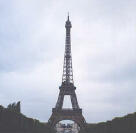 Republic
Republic
MonetaryUnit
The French Franc (FF)
Capital
Paris 2,152,000 inhabitants (City of Paris); 10,740,000 inhabitants (Ile-de-France or Paris region)
Main cities
12 cities with more than 350,000 inhabitants, including Lyon1,260,000; Marseille1,200,000; Lille 1million; Bordeaux700,000; Toulouse 650,000; Nantes 500,000; Strasbourg 400,000...
Main rivers
Loire, Rh�ne, Seine, Rhine, Garonne
Main mountain ranges
Alps (Mont Blanc, highest European summit 4,808 m), Pyrenees, Massif Central, Jura, Vosges
Countries bordering France
Belgium, Luxembourg, Germany,Switzerland, Italy,Spain, Monaco and Andorra and accross the Channel, the United Kingdom
Bodies of water bordering France
the North Sea, the English Channel, the Atlantic Ocean and the Mediterranean Sea
The romance of France lies not only in its remarkable cultural and architectural heritage, enviable cuisine and world- renowned wines, but in its hidden treasures. The 22 provinces offer a variety of byways, revealing here a charming town with a lively food fair or traditional crafts, there an ancient village notable for a passionate artist or a famous writer.
.
Highlights
Paris, the grande dame of French art and heritage, offers much to look forward to in 1999 from the Champs Elys�e (where 1.5 million celebrated France's World Cup victory last year) to the new Museum of Jewish Art and History.
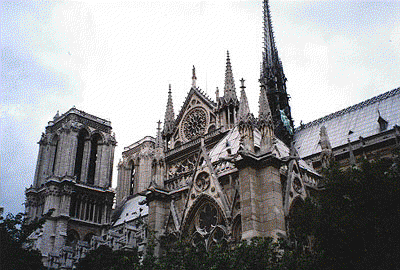 The grand Louvre expansion project comes to an end this spring, followed by the reopening of the Chatelet Theater (September) and of the Mus�e Guimet, Paris's major museum of Asian Art (November). At year's end, the Pompidou Center and its revamped Museum of Modern and Contemporary Art will again welcome visitors. And Notre Dame will shed its scaffolding after seven years of restoration.
The grand Louvre expansion project comes to an end this spring, followed by the reopening of the Chatelet Theater (September) and of the Mus�e Guimet, Paris's major museum of Asian Art (November). At year's end, the Pompidou Center and its revamped Museum of Modern and Contemporary Art will again welcome visitors. And Notre Dame will shed its scaffolding after seven years of restoration.
The �le-de-France region surrounding Paris has a dozen castles, including Vaux-le-Vicomte, and the stately ch�teaux of Versailles and Fontainebleau. Explore the small towns and villages once home to famed artists, from Sisley's Milly-la-For�t to Van Gogh's Auvers-sur-Oise.
The Loire Valley sparkles with famous ch�teaux, including the stately Chambord and 16th-century Chenonceau, bridging the Cher river. Medieval Loches, birthplace of poet Alfred de Vigny, boasts a 13th- to 16th-century castle; while Bourges is famed for its cathedral, old quarter and Gothic Palais Jacques Coeur.
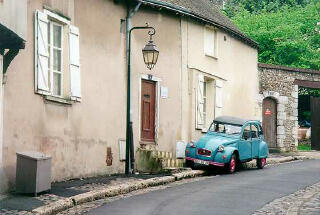 Brittany has 800 miles of rocky coastline, scores of fishing villages and a Celtic heritage. The July Festival de Cornouaille in Quimper (famous for its fa�ence) draws thousands of music and dance groups from Ireland, Scotland and other Celtic communities.
Brittany has 800 miles of rocky coastline, scores of fishing villages and a Celtic heritage. The July Festival de Cornouaille in Quimper (famous for its fa�ence) draws thousands of music and dance groups from Ireland, Scotland and other Celtic communities.
Burgundy is known for its dukes, prestigious wines and distinctive cuisine. Many vineyards and wineries can be visited by tour or by appointment. The countryside and magnificent estates can be admired from a hot-air balloon; the network of rivers and canals is ideal for barge excursions. Among the towns celebrated for remarkable architecture are Beaune, also noted for its wine market and the Three Days of Glory in November; Dijon, of mustard fame; and medieval V�zelay.
Normandy honors World War II veterans on June 5 and 6, the 55th anniversary of the D-Day landings. Important sites include the American Cemetery at Colleville-sur-Mer, Caen�s Memorial/Museum for Peace, and the actual Utah and Omaha beaches. At Arromanches, see the remains of the Allies� artificial �Mulberry� harbor.
The regions of Provence and Languedoc-Roussillon are home to Roman ruins and historic artists' cities, as well as to market towns and villages. Orange and Aix-en-Provence boast major music festivals. Prades hosts the Pablo Casals Festival and C�ret features the traditional Sardannes dance celebration. Van Gogh favored Arles and St-R�my, the Fauvists chose the port village of Collioure, while C�zanne remains Aix's favorite son.
The Roman heritage trail includes the well-preserved amphitheaters of Nimes, Arles, Orange and Vaison-la-Romaine, and the three-tiered Roman aqueduct, Pont-du-Gard. Marseille, the second-largest city, is the oldest of the great French ports.
 The Riviera is world-renowned as the home of the film festival in Cannes and as the favorite playground of the rich and famous. But under the azure skies also lies a cultural heritage second only to Paris, with more than 200 museums and artists' homes.
The Riviera is world-renowned as the home of the film festival in Cannes and as the favorite playground of the rich and famous. But under the azure skies also lies a cultural heritage second only to Paris, with more than 200 museums and artists' homes.
Medieval hilltop villages like Vence, Biot, Hauts-de-Cagnes and St-Paul are synonymous with Matisse, Renoir and the Fondation Maeght, while on the coast Nice, Antibes, Villefranche-sur-Mer and Menton claim the legacies of Marc Chagall, Pablo Picasso and Jean Cocteau. Grasse is the center of the fragrance region of perfumes, cut flowers; the lively Mimosa Festival takes place in Mandelieu-La Napoule. High-perched �ze boasts artists� workshops and local crafts, rivaled by the glassworks of Biot and ceramics of Vallauris.
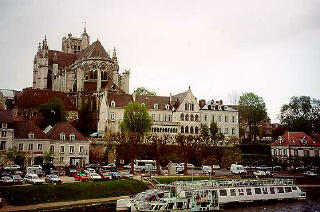 The Rh�ne-Alps regions offer visitors a wide variety of experiences. Lyon, where the Sa�ne meets the Rh�ne, is famed for its outstanding restaurants, Roman ruins and old quarter with the unique passageways called traboules. Nearby are the celebrated vineyards of the Beaujolais.
The Rh�ne-Alps regions offer visitors a wide variety of experiences. Lyon, where the Sa�ne meets the Rh�ne, is famed for its outstanding restaurants, Roman ruins and old quarter with the unique passageways called traboules. Nearby are the celebrated vineyards of the Beaujolais.
The French Alps soar from Lake Geneva to the Mediterranean, and boast the highest peak in Western Europe, Mont Blanc (15,781 feet). The 1992 Winter Olympics were held at Albertville in the Savoie region, with improved facilities and easier access to the 10 Olympic venues. A former Olympic site, Grenoble is the chief city, and Courchevel is one of France's premier resorts.
Alsace is known for its distinctive medieval villages, half-timbered houses and celebrated wine route between Colmar and Strasbourg. The latter, home to the European Parliament, offers a new Museum of Modern and Contemporary Art on the Rhine bank.
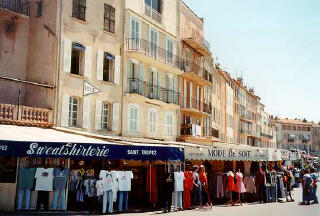 Food & Drink
Food & Drink
French chefs display their finesse on everything from tarts to truffles, onion soup to oysters, and snails to souffl�s. Regional specialties abound, such as the famed bouillabaisse of Marseille, the escargots and beef stew of Burgundy, and Alsatian choucroute garni (sauerkraut garnished with potatoes and sausages). Fall through spring is the season for mussels and oysters in Brittany, where pastries are also special. Normandy's cheeses are justly famous, as is its butter-and cream-based cuisine.
French wines, of course, are a glory in themselves.
Shopping
Specialties include fashions, perfumes, cosmetics, crystal, porcelain and pottery, jewelry, cutlery, gourmet foodstuffs, knitwear, lace, textiles and tapestries.
Major shopping neighborhoods in Paris include the Palais des Congr�s de Paris, the Montparnasse and St-Germain areas, and the Forum des Halles. Department stores can be found on the grands boulevards and rue de Rivoli. Antiques dealers concentrate in the area around the Mus�e d'Orsay. Major department stores include Printemps, Carrousel and the century-old Galeries Lafayette.
 Return to the Fridge door
Return to the Fridge door